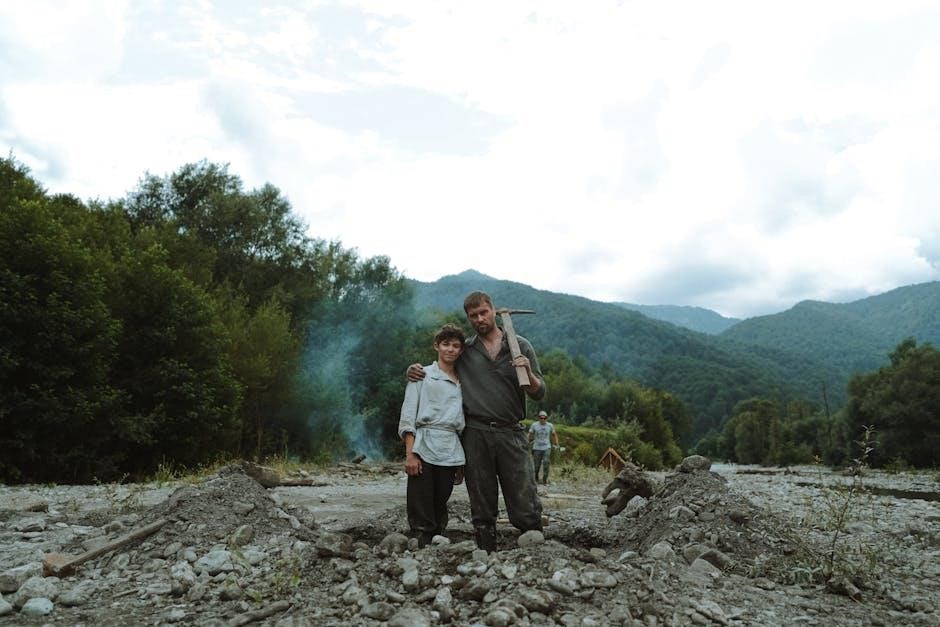No-grid survival projects offer practical guides for self-reliant living, empowering individuals to thrive without public utilities. These resources provide step-by-step DIY solutions for emergency preparedness and sustainable independence.
Understanding Off-Grid Living
Off-grid living is a lifestyle that operates independently of public utilities, such as electricity, water, and gas. It emphasizes self-sufficiency and reliance on renewable resources. Homes in this system are autonomous, generating their own energy and managing water and waste without external infrastructure.
This approach requires careful planning and skill, as it involves sourcing power from solar, wind, or hydro systems and collecting or purifying water. Off-grid living is not just about survival; it’s a sustainable way to reduce environmental impact and achieve independence from modern conveniences.
Why Choose No-Grid Survival?
Choosing no-grid survival offers freedom from reliance on public utilities, empowering individuals to live independently and sustainably. This lifestyle reduces dependence on external systems, lowering costs and enhancing self-reliance. It prepares individuals for emergencies, such as blackouts or natural disasters, ensuring continuous access to essential resources like power and water. Additionally, no-grid survival aligns with eco-friendly living, minimizing environmental impact through renewable energy and efficient resource management. It fosters a sense of security and self-sufficiency, allowing individuals to thrive in challenging situations. By embracing this approach, you gain control over your lifestyle, resources, and future, making it a practical and fulfilling choice for those seeking independence and resilience.

Essential Shelter Solutions
Reliable shelter is crucial for no-grid survival, offering protection from harsh environments and ensuring safety. It involves using natural materials and repurposed resources to create durable, adaptable structures.
DIY Shelter Options
DIY shelter options are essential for no-grid survival, offering practical solutions for creating safe and durable structures. These include earthship homes, tiny houses, and cabins built from recycled materials. Many guides provide step-by-step instructions for constructing shelters using natural materials like wood, earth, and repurposed items. Some projects emphasize simplicity, such as building a micro-cabin or a survival hut, while others focus on sustainability, like using straw bales or rammed earth. Additionally, resources often highlight tips for optimizing space, insulation, and ventilation to ensure comfort and resilience. These DIY projects empower individuals to create reliable shelters without reliance on modern infrastructure, making them ideal for remote or emergency situations. Free PDF guides and tutorials are widely available, offering detailed plans and expert advice for beginners and experienced builders alike.
Building and Maintaining Your Shelter
Building and maintaining your shelter is crucial for long-term survival off-grid. Start with durable materials like wood, metal, or earth, ensuring structural integrity. Regular inspections are essential to identify and repair weaknesses. Apply protective coatings to prevent weather damage and rot. Proper insulation and ventilation are key for temperature regulation and moisture control. Clear drainage systems around the shelter to prevent water accumulation, which can compromise stability. Reinforce the structure with anchors or support beams for added stability. Regular maintenance tasks, such as replacing damaged roofing or sealing gaps, ensure your shelter remains secure. Detailed guides and tutorials in no-grid survival PDFs provide step-by-step instructions for these processes, helping you maintain a safe and reliable shelter in any environment.

Power Generation and Management
Power generation is crucial for off-grid living, relying on renewable energy sources like solar, wind, and hydro. Backup systems, such as batteries and generators, ensure continuous energy supply.
Renewable Energy Sources
Renewable energy is a cornerstone of no-grid survival, offering sustainable power solutions. Solar energy, harnessed through photovoltaic panels, is a popular choice due to its accessibility and low maintenance. Wind energy, utilizing turbines, is ideal for areas with consistent airflow. Hydro energy, generated from flowing water, provides reliable power in suitable locations. These systems reduce reliance on fossil fuels and lower long-term costs. Geothermal energy, though less common, leverages Earth’s heat for heating and cooling. Energy storage solutions, such as deep-cycle batteries, ensure power availability during periods of low generation. Backup generators, fueled by propane or diesel, offer additional security. Proper planning and resource assessment are crucial for maximizing renewable energy potential and achieving energy independence.
Backup Power Systems
Backup power systems are essential for ensuring continuous energy supply during outages or low renewable generation. Portable generators, fueled by propane or diesel, offer reliable short-term power solutions. Battery banks, paired with inverters, provide stored energy for extended periods. UPS systems protect sensitive electronics during transitions. These systems require careful planning, considering fuel availability, storage capacity, and maintenance needs. Regular testing and maintenance are crucial to ensure reliability. Energy storage solutions, like deep-cycle batteries, complement backup systems by stabilizing power supply. Understanding local regulations and safety precautions is vital. Backup systems enhance resilience, allowing off-grid homes to remain functional during emergencies or grid failures, ensuring consistent power availability and peace of mind.

Water Sourcing and Management
Water sourcing involves rainwater harvesting, wells, and natural springs. Effective management includes filtration, purification, and storage systems to ensure clean water availability year-round for off-grid living.
Water Collection Methods
Effective water collection is crucial for off-grid survival. Rainwater harvesting is a popular method, using barrels or tanks to gather and store rainwater from rooftops. Wells and natural springs provide reliable groundwater sources, requiring minimal equipment. For areas with high humidity, fog collection systems can be implemented using mesh or fabric to condense water. Surface water from rivers, lakes, or ponds is another option, though it often needs filtration. Each method requires proper planning and maintenance to ensure sustainability and water quality. Understanding these techniques is essential for creating a self-sufficient water supply, especially in remote or challenging environments.
Water Purification Techniques
Water purification is essential for ensuring safe drinking water in off-grid environments. Boiling water is a simple and effective method to kill bacteria, viruses, and parasites. Filtration systems, such as sand or charcoal filters, remove impurities and improve water clarity. Distillation involves boiling water and condensing the vapor to eliminate contaminants. Chemical disinfection, using chlorine or iodine, is another reliable method; Additionally, solar disinfection (SODIS) uses sunlight to kill pathogens when water is stored in clear containers. For off-grid survival, portable water purification tablets or straw filters are convenient options; Combining multiple methods ensures the highest level of water safety. Proper purification techniques are critical for maintaining health and preventing waterborne illnesses in self-sufficient living situations.

Food Production and Storage
Off-grid food production involves sustainable gardening and farming techniques, while storage methods like canning and dehydrating ensure long-term sustainability and self-sufficiency.
Gardening and Farming Off-Grid
Gardening and farming off-grid focus on sustainable practices to grow food independently. Techniques include permaculture, composting, and rainwater harvesting to maximize productivity. Hydroponics and aquaponics offer space-saving solutions for fresh produce. Heirloom seeds ensure biodiversity and self-reliance. Renewable energy tools, like solar-powered irrigation, enhance efficiency. These methods reduce reliance on external systems, promoting food security and resilience. off-grid farming also embraces animal husbandry, providing meat, dairy, and eggs. Proper planning and resource management are key to thriving in self-sufficient agriculture. These practices empower individuals to cultivate their own food, ensuring a steady supply even without modern conveniences. off-grid gardening and farming are cornerstone skills for a sustainable lifestyle.
Food Preservation Methods
Food preservation is critical for maintaining sustenance in off-grid living. Techniques like canning, dehydrating, and fermenting extend shelf life and retain nutrients. Root cellars store vegetables naturally, while smoking and curing preserve meats. Fermentation enhances flavor and nutrition, creating staple foods like sauerkraut and yogurt. These methods ensure a steady food supply, regardless of seasonal availability. off-grid survival guides detail simple, effective preservation strategies to safeguard harvests and reduce waste. By mastering these approaches, individuals can enjoy fresh, healthy meals year-round, enhancing self-reliance and food security.

Waste Management Strategies
Effective waste management is essential for sustainability. Recycling, composting, and proper disposal methods minimize environmental impact. Biogas systems convert organic waste into energy, promoting eco-friendly practices.
Recycling and Composting
Recycling and composting are vital for minimizing waste in off-grid living. Separate recyclable materials like metal, glass, and plastic for reuse or proper disposal. Composting organic waste reduces landfill contributions and creates nutrient-rich soil for gardening. Use kitchen scraps, leaves, and grass clippings to build compost piles, ensuring a balanced mix of “green” and “brown” materials. Regularly aerate and maintain the compost to speed up decomposition. Additionally, repurpose non-compostable items creatively, such as turning old containers into storage solutions. Implementing these practices reduces waste, conserves resources, and supports a sustainable lifestyle. Composting also reduces the need for synthetic fertilizers, fostering healthier crops and a more self-sufficient system.
Sanitation Solutions
Sanitation solutions are essential for maintaining hygiene and health in off-grid living. Composting toilets and outhouses are popular choices, converting human waste into safe, usable compost. Proper waste disposal systems, such as septic tanks or shallow pit latrines, prevent contamination of water sources. Handwashing stations using rainwater or solar-heated water promote cleanliness. Natural cleaning agents like vinegar and baking soda replace chemical-based products, reducing environmental impact. Regular maintenance of sanitation systems is critical to prevent odors and pests. Implementing these solutions ensures a hygienic environment, protecting both health and the surrounding ecosystem. Effective sanitation practices are vital for sustaining a clean and self-sufficient lifestyle off the grid.

Financial Strategies for Sustainability
Budgeting, bartering, and alternative economies are key to off-grid sustainability. Prioritize cost-effective DIY projects and invest in renewable systems to reduce long-term expenses and achieve financial independence.
Budgeting for Off-Grid Living
Budgeting for off-grid living requires careful planning to balance upfront costs with long-term savings. Prioritize essential systems like renewable energy and water collection, as they are critical for sustainability. Allocate funds for solar panels, wind turbines, and water filtration systems, which may be expensive initially but offer significant savings over time. Consider DIY projects to reduce labor costs, using free online guides for inspiration. Set aside a portion of your budget for maintenance and repairs, as off-grid systems require regular upkeep. Additionally, explore bartering and alternative economies to reduce expenses. By strategically managing your finances, you can achieve financial independence and enjoy the benefits of a self-sufficient lifestyle.
Bartering and Alternative Economies
Bartering and alternative economies are vital for off-grid survival, enabling resource exchange without relying on cash. Communities often trade goods like food, tools, and skills, fostering mutual support. Alternative systems, such as local currencies or time banks, promote sustainability and reduce dependence on external systems. These methods strengthen community bonds and ensure access to essential resources during crises. By leveraging bartering, individuals can acquire necessities without financial strain, while alternative economies provide innovative solutions for resource management. Such systems not only enhance self-reliance but also encourage collaboration, making them cornerstone strategies for thriving off-grid.
Emergency Preparedness
Essential for survival, emergency preparedness involves creating bug-out bags, communication plans, and knowing how to build shelter and find food in crisis situations.
Creating a Bug-Out Bag
A bug-out bag is a portable kit essential for emergency evacuation, containing items to sustain life for at least 72 hours. It should include essentials like water (1 gallon per person per day), non-perishable food, first aid supplies, and a multi-tool or knife. Extra clothing, sturdy shoes, and a blanket or emergency shelter are crucial. A flashlight, extra batteries, and communication tools like a portable radio or whistle should be included. Personal documents, such as identification and cash, are also vital. Maps of the area and a compass can help with navigation. Consider adding a water filtration system or purification tablets for safe drinking water. Organize items in a durable, easy-to-carry backpack to ensure quick access during crises. Regularly update and check the bag to ensure all supplies remain usable and relevant.
Emergency Communication Plans
Effective communication is crucial during emergencies, especially when off-grid. A well-prepared communication plan ensures family members can stay in touch and coordinate actions. Essential items include a portable radio, two-way radios, or a satellite phone for real-time updates and contact. Whistles can signal for help when verbal communication fails. Pre-program important numbers and establish a meeting point in case of separation. Consider solar-powered chargers for cell phones and other devices. Regularly test equipment to ensure functionality. Store a physical map for navigation and mark safe zones. Teach all family members how to use the devices. Update the plan periodically to adapt to changing circumstances. A reliable communication strategy enhances safety and unity during crises.

Legal and Ethical Considerations
Navigating legal requirements and ethical practices is vital for off-grid survival. Ensure compliance with local permits and zoning laws while respecting environmental and community standards.
Permits and Zoning Laws
Understanding and complying with local permits and zoning laws is crucial for off-grid survival projects. Many jurisdictions require approvals for alternative energy systems, water collection methods, and unconventional housing. Researching and obtaining necessary permits ensures legal compliance, avoiding potential fines or project shutdowns. Zoning laws may restrict certain off-grid activities, such as water harvesting or DIY shelters, in specific areas. It’s essential to engage with local authorities early in the planning process to understand regulations and adapt designs accordingly. This proactive approach helps maintain harmony with the community while achieving self-sufficiency goals. Always verify legal requirements to ensure your off-grid project remains compliant and sustainable long-term.
Ethical Practices in Off-Grid Living
Ethical practices are fundamental to sustainable off-grid living, ensuring harmony with nature and local communities. Key principles include minimizing environmental impact by using renewable resources responsibly and reducing waste. Respect for wildlife and ecosystems is vital, avoiding practices that disrupt natural habitats. Additionally, fostering community relationships through shared knowledge and resources promotes mutual support. Ethical off-grid living also involves fair labor practices and sourcing materials sustainably. By adhering to these guidelines, individuals can maintain a self-sufficient lifestyle while contributing positively to the environment and society. This approach not only supports personal well-being but also upholds global sustainability goals for future generations.

Community Building and Networking
Building a supportive network is crucial for off-grid survival, fostering collaboration and resource sharing among like-minded individuals to enhance resilience and collective growth.
Joining Off-Grid Communities
Joining off-grid communities provides invaluable support and resources for those embracing self-sufficiency. These groups, often found online or locally, foster collaboration and knowledge sharing. Members gain access to expertise, tools, and shared experiences, enhancing their ability to thrive independently. Many communities organize workshops, skill swaps, and mutual aid programs, strengthening resilience; For example, groups like Off the Grid: Eastern Canada have seen significant growth, reflecting the rising interest in sustainable living. Participating in such networks not only builds friendships but also creates a safety net during emergencies. By connecting with like-minded individuals, off-grid enthusiasts can overcome challenges more effectively, ensuring a more sustainable and fulfilling lifestyle. These communities embody the spirit of cooperation essential for long-term independence.
Shared Resources and Knowledge
Shared resources and knowledge are cornerstone of thriving off-grid communities. Many groups establish shared libraries of tools, manuals, and guides, ensuring members have access to essential information. Communities often collaborate on large projects, pooling skills and materials to achieve common goals. Online forums and local meetups facilitate knowledge exchange, with members sharing tips on everything from renewable energy to food preservation. These networks also promote resource sharing, such as borrowing equipment or exchanging surplus goods. By fostering cooperation, off-grid communities reduce costs and enhance resilience. Shared knowledge empowers individuals to overcome challenges, while collective resources strengthen the community’s ability to adapt and thrive. This collaborative approach is vital for sustainable, self-reliant living.

Maintenance and Troubleshooting
Regular system checks and timely repairs are vital for off-grid sustainability. Troubleshooting guides and maintenance schedules ensure longevity of equipment and prevent unexpected failures, securing reliable resources.
Scheduling Regular Maintenance
Regular maintenance is crucial for ensuring the longevity and efficiency of off-grid systems. Start by creating a detailed schedule that outlines tasks to be performed monthly, quarterly, and annually. Prioritize inspections of power generation systems, such as solar panels and wind turbines, to ensure optimal energy production. Water collection and purification systems also require consistent checks to prevent contamination and blockages. Additionally, schedule routine maintenance for waste management systems to avoid backups and health hazards. Organize your tasks using a digital or physical calendar, and allocate time for unexpected repairs. By adhering to a structured maintenance plan, you can prevent system failures and ensure a sustainable off-grid lifestyle. Regular checks also help identify potential issues before they escalate, saving time and resources in the long run.
Common Issues and Solutions
Off-grid living often presents unique challenges, such as power outages, water contamination, and system breakdowns. One common issue is equipment failure due to lack of maintenance, which can disrupt energy and water supplies. Another problem is pest infestations in food storage areas, threatening sustainability. To address these, regular inspections of solar panels, wind turbines, and water filtration systems are essential. Backup generators and redundant systems can mitigate power failures. For pest control, natural deterrents like diatomaceous earth or sealing entry points are effective. Additionally, maintaining a well-stocked repair kit and staying informed about weather patterns can help anticipate and resolve issues. By identifying common problems and implementing practical solutions, off-grid residents can ensure a more resilient and self-sufficient lifestyle.
Advanced Off-Grid Projects
Earthship construction and aquaponics/hydroponics offer innovative solutions for sustainable living. These advanced projects promote self-sufficiency through eco-friendly housing and efficient food production, enhancing off-grid resilience and independence.
Earthship Construction
Earthship construction is an advanced off-grid project that involves building eco-friendly, self-sufficient homes using recycled and natural materials. These structures are designed to harness natural energy, such as solar and thermal power, to maintain a stable indoor climate without external utilities. Earthships often incorporate rainwater harvesting systems, composting toilets, and renewable energy sources, making them highly sustainable. They are typically built into the ground to maximize insulation and energy efficiency. Guides and resources detail how to design and construct Earthships, emphasizing eco-friendly practices and minimal environmental impact. This innovative approach to housing provides a long-term solution for off-grid living, combining functionality with environmental stewardship.
Aquaponics and Hydroponics
Aquaponics and hydroponics are innovative farming methods that enable sustainable food production without relying on traditional soil-based agriculture. Aquaponics combines aquatic life, such as fish, with plant cultivation in a closed-loop system, where waste from fish serves as fertilizer for plants. Hydroponics, on the other hand, grows plants in nutrient-rich water rather than soil. Both systems are highly efficient in water use and can be powered by renewable energy sources. These methods are ideal for off-grid environments, providing fresh produce year-round. Guides offer detailed instructions for setting up these systems, ensuring food security and self-sufficiency. By integrating these technologies, individuals can maintain a reliable food supply even in challenging conditions. This approach aligns perfectly with the principles of off-grid living, promoting sustainability and resilience.
Embrace the empowering journey of no-grid survival projects, fostering resilience and self-sufficiency. Start small, stay committed, and transform your life with sustainable, independent living solutions today.
Summarizing the Journey
The journey through no-grid survival projects is a transformative path toward self-reliance and sustainability. It equips individuals with essential DIY skills, from building shelters to harnessing renewable energy, ensuring independence from public utilities. By mastering these projects, one gains the confidence to face emergencies and thrive in off-grid environments. The comprehensive guides and step-by-step instructions empower anyone to start small and gradually build a resilient lifestyle. This journey is not just about survival but about embracing a fulfilling, eco-conscious way of living. It encourages preparedness, creativity, and a deeper connection with nature, making it a rewarding adventure for those committed to sustainability and independence.
Starting Your Off-Grid Adventure
Embarking on an off-grid adventure begins with a clear vision and practical steps. Start by assessing your skills, resources, and goals to create a personalized plan. Begin with small, achievable projects, such as installing a rainwater collection system or setting up a solar-powered energy source. Educate yourself using free PDF guides and online resources to gain confidence in DIY techniques. Connect with off-grid communities for support and inspiration. Remember, this journey is about progress, not perfection. Stay patient, persistent, and open to learning. By taking the first steps, you’ll pave the way for a more self-reliant and sustainable lifestyle, reducing your dependence on public utilities and embracing nature’s abundance.

